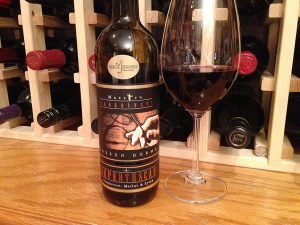Ecco Domani Prosecco 2013: Light, slightly fizzy, crisp, clean; citrus, green apple, honey; creamy sweet with excellent balancing acidity, nice finish. Works well with food and as aperitif. Northeast Italy’s Prosecco had cooler growing season than normal in 2013, which made this wine more delicate and with very fresh acidity (3.14 pH). Ecco Domani translates to “Here’s Tomorrow,” and this is tasty way to salute the future; at 10.5% alcohol, you also would have to drink a lot to fear a morning hangover. Nice value a range of palates will enjoy. $11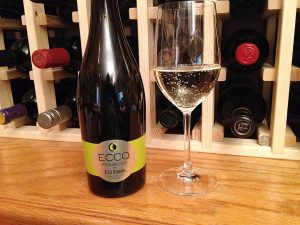
Month: July 2015
Joel Gott Pinot Noir California 2013
Joel Gott Pinot Noir California 2013: Ripe cherry fruitiness, some cedar and spice, fig, raspberry; juicy, balanced, soft tannin, smooth, wisely gentle on the oak. Joel Gott also makes an Oregon version that sells for about $7 more; California (Santa Barbara, Monterey counties) is the more widely-distributed. Joel Gott is real person; his grandfather was winemaker and president of Inglenook in the 60s and 70s; his father founded Montevina. Joel Gott Winery is partnership with Trinchero Family Estates, which is part of Sutter Home Winery (best know for inventing white zinfandel); Sutter Home is one of the largest family-owned wine companies in US (Gallo is first). Joel Gott is known for affordable, available, consistent quality-for-price pours; this upholds that tradition. $18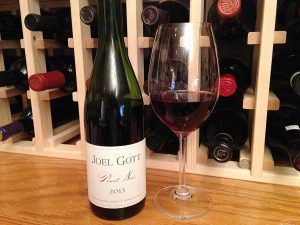
Thomas Fogarty Santa Cruz Mountains Merlot 2009
Thomas Fogarty Santa Cruz Mountains Merlot 2009: Candied cherry, plum, blackberry, raspberry; ripe fruit-forward, plenty of sweet oak, vanilla; velvety soft, simple plushness, very reserved tannin and acidity. Will certainly appeal to folks who enjoy the soft, big-in-the-mouth, oak-and-fruit storm style of California reds. Merlot is like a movie starlet who makes a big splash (in the 1990s), then struggles in the next part. Merlot’s best role is as a complement to cabernet sauvignon, where it humanizes cab’s austerity and puckering tannins. In U.S., however, it became an entry-level to red varietals for those put off by more serious reds; its pliant softness and gentle tannins were a plus. Then, American palates matured, the movie Sideways came out, and suddenly pinot noir was the next big thing and merlot was so, so last century. This Thomas Fogarty effort has its niche; give it a try. $23-33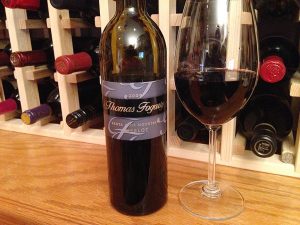
Château La Tour de Bessan Margaux 2010
Château La Tour de Bessan Margaux 2010: Solid, rich, smoky; plum, blackberry, cherry, nice nip of blackcurrant to keep things interesting, leather; medium body, elegantly smooth in the mouth with silky tannin, balancing acidity; 64% cab, 33% merlot, 3% cab franc; thoroughly delicious and superb value for a Margaux Cru Bourgeois (one critic: “best value in 2010 Margaux). In 1992, Marie-Laure Lurton inherited from her father vineyards once owned by the son of French lawyer, writer, and political philosopher Baron de Montesquieu. She rebuilt the operation from the ground up: replanting, replacing, modernizing, taking Château La Tour from a mess to an operation critics eagerly await each vintage to enjoy the continuing improvement. This is classic Bordeaux, classic blend, delicious, at a price many can afford. $27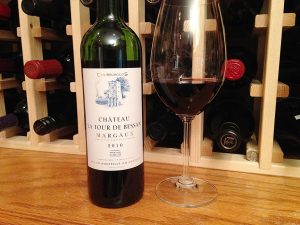
Giesen New Zealand Riesling 2013
Giesen New Zealand Riesling 2013: Pinch of petrol, flint on the nose; lemon grass, honeysuckle, citrus, green apple, tart lime and minerals on the back end; juicy, vivid fruit; medium-sweet, lush mouth, fresh acidity. When you think New Zealand wine, you usually think sauvignon blanc and—increasingly—pinot noir, but this is tasty delight that nicely asserts its place. It is a bit past off-dry and moving into the medium-sweet range, so it should be crowd pleaser to those who enjoy a blush of fruity sweetness in their wine; it’s acidity will placate those who prefer a drier riesling style. $14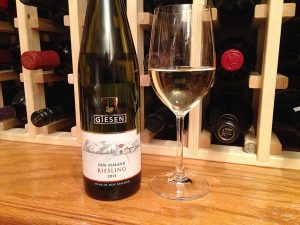
HandCraft Artisan Collection Pinot Grigio 2014
HandCraft Artisan Collection Pinot Grigio 2014: Light flowers-lemon nose; exceptionally clean, with demure honeydew melon, lemon. HandCraft Artisan Collection wines are made by DFV Wines, a California winery founded by Idelicato family in 1924; Cheryl Indelicato is today’s maker (third generation) and adds her signature to Artisan Collection labels. The family prides itself on blending California and Italian wine traditions; winemaking comments on this effort note a “playful dash of Italian grape varieties are added as a nod to the vineyard-to-barrel field selections that found their place daily at the table when she was growing up.” This is light, breezy effort that is simple and tasty; a classic easy summer sipper. $12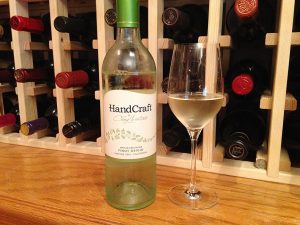
Fattori Amarone Della Valpolicella Gregoris 2008
Fattori Amarone Della Valpolicella Gregoris 2008: Deliciously smooth, semi-bold for Amarone (but bold for any other wine), opulent fruit, plum, sour cherry, hint of vanilla; fresh, clean, elegant; balancing acidity. Amarone is made from corvina and corvinone, helped by rodinella and molinara, grapes found only in Valpolicella. After harvest, grapes dry on bamboo racks from October to February, a process called appossimento that reduces water by 40 percent. When crushed, the almost-raisin results make wine beautifully fruity, wonderfully smooth, famously high alcohol (this is 15%). Fattori’s effort is crushed and fermented with natural yeasts in wood barrels, then aged almost three years in barrels before bottling to add structure and complexity. All this effort makes amarone a pricey wine, so this delicious effort is real value. You can find bigger, bolder, more-wow amarone, but this excels at $40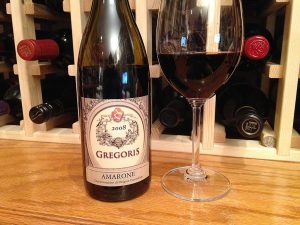
Ponzi Vineyards Chardonnay Reserve Willamette Valley 2012
Ponzi Vineyards Chardonnay Reserve Willamette Valley 2012: A delightful, certified organic offering from skilled Oregon maker (Luisa Ponzi, second generation of Ponzi family winemakers). Peach, nectarine on the nose; yellow peach on the palate, along with a pinch of pineapple, tangerine; lilt of lemon and crème brûlée on the satisfying, silky finish; medium body, superb acidity. Fermented in oak using wild yeast, 100% malolactic fermentation, stirred on the lees once a week for six months to develop depth and graceful character, aged in neutral oak barrels for 18 months. This is clean, pure, delicious expression of chardonnay. The Willamette Valley (south of Portland) takes its place among the special wine regions of the world, notable for the strictest label laws in the U.S. and commitment to environment and worker-friendly agriculture. Oregon is better known for delicate, superb pinot noir, but—like Burgundy—acres that grow great pinot also grow great chard. This is refined, tasty example. $34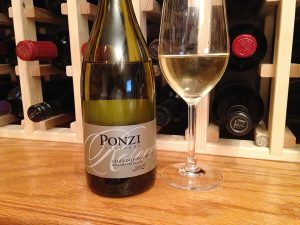
Columbia Winery Columbia Valley Cabernet Sauvignon 2013
Columbia Winery Columbia Valley Cabernet Sauvignon 2013: Almost black color; neutral nose; blackberry, cherry, blackcurrant tang, black olive on the palate; mild tannin and acidity, smooth, easy drinker. Cabernet sauvignon 81%, syrah 13%, malbec 3%, other red grapes 3%. The Columbia Valley is The State of Washington’s largest appellation with more than 60% of the wine grape planting (17,000 acres); it even includes part of Oregon. You generally think of the northwest as a temperate rain forest, but wine is done in the shrub steppe lands on the eastern side of the Cascade Mountains; vineyards get about eight inches of rain annually and 16 hours of sunlight daily (Oregon’s vineyards are similar). The Columbia Valley does have the mighty Columbia River—largest river in the Pacific Northwest, 1,243 miles long, flowing through a Canadian province and seven states, draining an area the size of France. So there is water to be had, and Washington vintners use their terroir and their water rights to make excellent wine; Washington and New York tie for second in U.S. grape production (each with 3.5% of U.S. total), but Washington has more wineries and usually produces slightly more wine. Texas ranks around fifth-to-seventh, depending on who is counting and how they count. California dominates, by the way, with almost 89% of U.S. wine and grape production. $16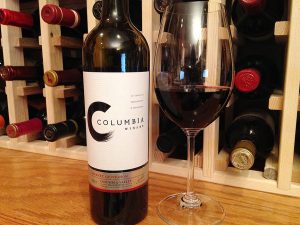
Maestro Sanguineti Nessun Dorma Super Tuscan 2012
Maestro Sanguineti Nessun Dorma Super Tuscan 2012: Very smooth, approachable Super Tuscan blend—50% sangiovese, 30% merlot, 20% syrah. Drinks almost like a fruity California red; ripe cherry, strawberry, red fruits galore, some blackberry, too; fresh, bright, medium tannin and acidity. This clearly is not a smack-you-in-the-face brute that some Super Tuscans can be (thanks to absence of cab); the syrah struggles to add heft and complexity to the mild-mannered sangiovese and merlot. Super Tuscan wines are product of 1970s revolt by some Chianti makers who bridled under prohibitions against using cab, merlot, and syrah in their blended wines. Super Tuscan term not only had macho appeal, it set their wine apart from lower-quality Chianti table wines dominating Chianti bottlings back then. Super Tuscans found their audience, and Chianti makers stepped up, too, making for better times for wine drinkers ever since. Winemaker Antonio Sangineti named this after his favorite favorite Pucinni aria (“Non Shall Sleep”), a staple of Luciano Pavarotti (and The Three Tenors) concerts. This sings well too, but you should be able to sleep after sipping. $20